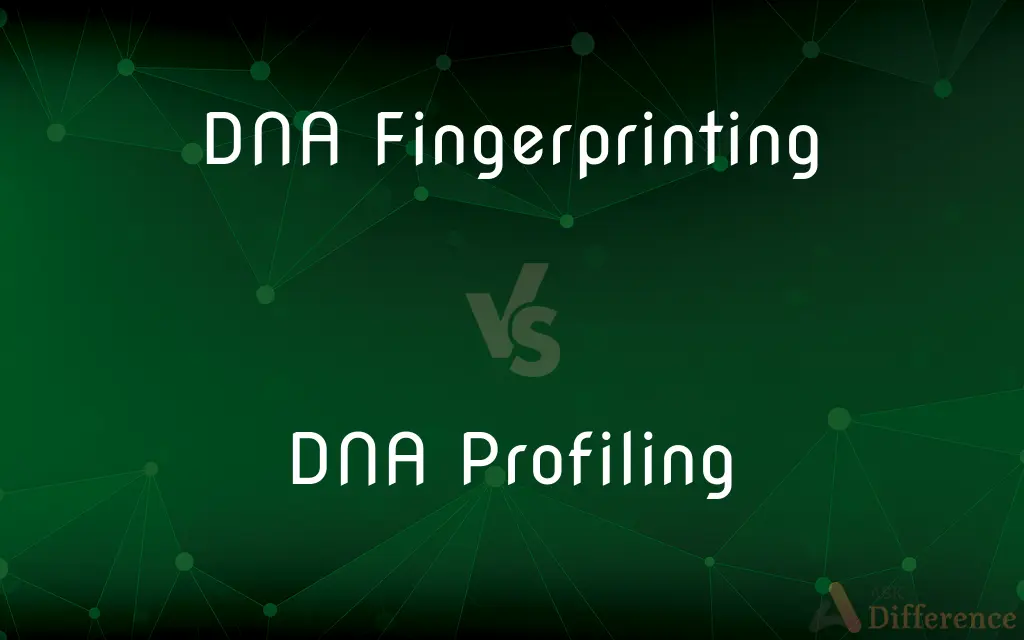DNA Fingerprinting vs. DNA Profiling — What's the Difference?
By Fiza Rafique & Urooj Arif — Published on February 24, 2024
DNA fingerprinting refers to the older method of detecting variations in DNA fragments and DNA profiling involves analyzing short tandem repeats (STRs) for a more precise identification. Both are techniques used to identify individuals based on their DNA.

Difference Between DNA Fingerprinting and DNA Profiling
Table of Contents
ADVERTISEMENT
Key Differences
DNA fingerprinting, a term coined in the 1980s, originally involved detecting variations in the DNA sequence by using techniques like restriction fragment length polymorphism (RFLP) analysis. This process generated a pattern of DNA fragments that could be visualized on a gel, somewhat akin to a barcode unique to each individual. This method was widely used for forensic purposes, paternity testing, and identifying genetic connections between individuals.
DNA profiling, on the other hand, represents the evolution of genetic identification techniques, utilizing short tandem repeats (STRs) and other specific DNA sequences to create a detailed and accurate profile of an individual's DNA. This approach focuses on analyzing specific regions of the genome that are highly variable among individuals, making it more precise and reliable for identifying individuals, even from minute samples of DNA.
DNA fingerprinting laid the groundwork for genetic identification, relying on the visual patterns of DNA fragments, while DNA profiling has significantly advanced the field. The latter uses automated, sophisticated techniques to analyze DNA more quickly and accurately, making it the standard method for forensic analysis, ancestry tracking, and medical diagnostics.
The transition from DNA fingerprinting to DNA profiling reflects technological advancements in molecular biology. DNA profiling's higher resolution and specificity allow for the identification of individuals with a greater degree of confidence, crucial in legal contexts and in complex cases where precise genetic information is necessary.
Both DNA fingerprinting and DNA profiling are foundational to modern genetic analysis, but DNA profiling has largely superseded DNA fingerprinting due to its enhanced precision, reliability, and applicability in various fields.
ADVERTISEMENT
Comparison Chart
Technique
Analyzes VNTRs
Analyzes STRs
Methodology
Gel electrophoresis
PCR and capillary electrophoresis
Resolution
Lower, patterns like barcodes
Higher, precise identification of STRs
DNA Quantity
Requires larger samples
Can work with smaller, degraded samples
Application
Early forensic science, paternity testing
Modern forensic analysis, disaster victim identification
Compare with Definitions
DNA Fingerprinting
Requires gel electrophoresis for visualization.
After electrophoresis, the DNA fingerprint showed a clear pattern distinguishing the samples.
DNA Profiling
A modern, precise method for genetic identification.
DNA profiling has become the gold standard in forensic science.
DNA Fingerprinting
Used in paternity testing and genetic linkage studies.
DNA fingerprinting confirmed the paternity of the child with a high degree of certainty.
DNA Profiling
Utilizes short tandem repeats (STRs) for analysis.
The STR analysis provided a detailed DNA profile that matched the suspect.
DNA Fingerprinting
An early genetic identification technique using patterns of DNA fragments.
DNA fingerprinting was pivotal in solving forensic cases in the late 20th century.
DNA Profiling
Applied in ancestry tracking and medical diagnostics.
DNA profiling helped trace the individual's ancestry back several generations.
DNA Fingerprinting
Focuses on the unique patterns produced by DNA fragments.
The suspect was identified through the unique DNA fingerprint obtained from the crime scene.
DNA Profiling
Involves automated sequencing and PCR.
Modern DNA profiling techniques rapidly process samples for quick identification.
DNA Fingerprinting
Relies on RFLP analysis.
RFLP analysis enabled the creation of DNA fingerprints from blood samples.
DNA Profiling
Offers high accuracy and reliability.
Due to its accuracy, DNA profiling is crucial in legal proceedings for evidence.
Common Curiosities
Can DNA profiling be used to determine genetic diseases?
Yes, DNA profiling can identify genetic predispositions to diseases by analyzing specific DNA markers associated with those conditions.
Is DNA fingerprinting still used today?
While the principles of DNA fingerprinting are foundational, modern genetic analysis primarily uses DNA profiling due to its greater accuracy and reliability.
What distinguishes DNA fingerprinting from DNA profiling?
DNA fingerprinting refers to older methods focusing on visual patterns of DNA fragments, while DNA profiling uses specific DNA sequences for precise identification.
What is the main advantage of DNA profiling over DNA fingerprinting?
The main advantage is its precision and reliability in identifying individuals, which is critical for forensic analysis, ancestry tracking, and diagnosing genetic conditions.
Are the results of DNA profiling admissible in court?
Yes, DNA profiling results are widely accepted in courts around the world as reliable scientific evidence for establishing or negating criminal involvement.
Can DNA profiling differentiate between identical twins?
Standard DNA profiling techniques may not differentiate between identical twins due to their identical DNA sequences, but advanced methods like whole-genome sequencing can reveal differences caused by mutations or epigenetic changes.
How has DNA profiling impacted forensic science?
DNA profiling has revolutionized forensic science by providing a highly accurate method for linking individuals to crime scenes, significantly improving the resolution of criminal cases.
How do STRs contribute to the effectiveness of DNA profiling?
STRs are highly variable among individuals, making them excellent markers for distinguishing between DNA samples with a high degree of accuracy.
What technological advancements have improved DNA profiling?
Advances in PCR technology, automated sequencing, and bioinformatics have greatly enhanced the speed, accuracy, and affordability of DNA profiling.
How is DNA profiling used in ancestry tracking?
It analyzes specific regions of DNA that vary among populations, providing insights into an individual's ethnic background and genealogical connections.
Share Your Discovery
Previous Comparison
Semiconservative Replication vs. Dispersive Replication
Next Comparison
Toyota Kluger vs. Mitsubishi OutlanderAuthor Spotlight
Written by
Fiza RafiqueFiza Rafique is a skilled content writer at AskDifference.com, where she meticulously refines and enhances written pieces. Drawing from her vast editorial expertise, Fiza ensures clarity, accuracy, and precision in every article. Passionate about language, she continually seeks to elevate the quality of content for readers worldwide.
Co-written by
Urooj ArifUrooj is a skilled content writer at Ask Difference, known for her exceptional ability to simplify complex topics into engaging and informative content. With a passion for research and a flair for clear, concise writing, she consistently delivers articles that resonate with our diverse audience.
















































